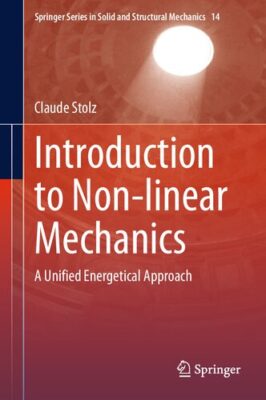Introduction to Non-linear Mechanics: A Unified Energetical Approach
Pdf Book Name: Introduction to Non-linear Mechanics: A Unified Energetical Approach
Author: Claude Stolz
Publisher: Springer Series in Solid and Structural Mechanics
ISBN-10, 13: 9783031519192,9783031519208
Year: 2024
Pages: 340 Pages
Language: English
File size: 7 MB
File format: PDF,EPUB

Introduction to Non-linear Mechanics: A Unified Energetical Approach
Books Details:
Non-linear mechanics is a branch of physics and engineering that deals with systems whose behavior is not proportional to the forces acting upon them. Unlike linear systems, which can be described by linear equations, non-linear systems often exhibit complex and unpredictable behavior, including chaotic dynamics, bifurcations, and self-organization.
The Energetical Approach
A unified energetical approach provides a powerful framework for analyzing and understanding non-linear systems. This approach focuses on the energy exchange between different components of the system, rather than on the detailed mathematical equations governing their behavior.
Key Concepts in Non-Linear Mechanics
Non-linearity:
Geometric Non-linearity: Arises from large deformations, leading to changes in the system’s geometry.
Material Non-linearity: Occurs when the material’s constitutive relations are non-linear, such as plasticity or viscoelasticity.
Chaos Theory:
Sensitive Dependence on Initial Conditions: Small changes in initial conditions can lead to dramatically different outcomes.
Strange Attractors: Complex geometric structures that attract the system’s trajectories.
Bifurcations:
Qualitative Changes: Sudden changes in the system’s behavior as a parameter is varied.
Bifurcation Diagrams: Visual representations of how the system’s behavior changes with parameter variations.
Limit Cycles:
Periodic Orbits: Self-sustained oscillations that the system converges to.
Self-Organization:
Emergent Behavior: The spontaneous formation of complex patterns and structures from simple interactions.
Applications of Non-Linear Mechanics
Non-linear mechanics has a wide range of applications in various fields, including:
Engineering:
Structural engineering: Analyzing the behavior of structures under extreme loads.
Mechanical engineering: Designing and analyzing non-linear systems like vibration absorbers and control systems.
Civil engineering: Modeling the dynamics of bridges, dams, and other infrastructure.
Physics:
Classical mechanics: Studying chaotic dynamics and nonlinear oscillations.
Fluid mechanics: Analyzing turbulent flow and wave propagation.
Biology:
Modeling biological systems like neural networks and heart rhythms.
Tools and Techniques
A variety of tools and techniques are used to analyze non-linear systems, including:
Analytical Methods:
Perturbation methods
Averaging methods
Asymptotic methods
Numerical Methods:
Finite element analysis
Finite difference methods
Computational fluid dynamics
Experimental Methods:
Laboratory experiments
Field measurements
By understanding the fundamental principles of non-linear mechanics and employing appropriate tools and techniques, engineers and scientists can analyze and design complex systems with greater accuracy and efficiency.
DMCA Disclaimer: This site complies with DMCA Digital Copyright Laws. Please bear in mind that we do not own copyrights to these books. We’re sharing this material with our audience ONLY for educational purpose. We highly encourage our visitors to purchase original books from the respected publishers. If someone with copyrights wants us to remove this content, please contact us immediately. All books on the edubookpdf.com are free and NOT HOSTED ON OUR WEBSITE. If you feel that we have violated your copyrights, then please contact us immediately (click here).



